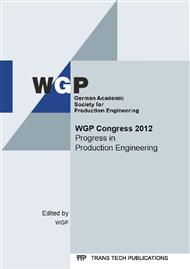[1]
European Union: Directive 2009/125/EC oft he European Parliament and oft he Council of 21 October 2009: establishing a framework for the setting of ecodesign requirements for energy-related products.
Google Scholar
[2]
VDMA (Hrsg. ) (2012): www. bluecompetence. net.
Google Scholar
[3]
Prognos (2006): Potenziale für Energieeinsparung und Energieeffizienz im Lichte aktueller Preisentwicklungen Berlin.
Google Scholar
[4]
N.N., (2009) Environmental management – Life cycle assessment – Principles and framework, DIN EN ISO 14040.
Google Scholar
[5]
N.N., (2006) Environmental management – Life cycle assessment – Requirements and guidelines, DIN EN ISO 14044.
Google Scholar
[6]
N.N. (2011) Environmental labels and declarations – Type III environmental declarations. Principles and procedures, DIN EN ISO 14025.
DOI: 10.3403/30101513u
Google Scholar
[7]
BMW Group (2008): Sustainable Value Report (2008).
Google Scholar
[8]
Daimler (2010): Daimler Sustainability report (2009).
Google Scholar
[9]
PE International AG (Hrsg. ) (2011): The EPD 2. 0 concept. a new way of integrating life cycle management.
Google Scholar
[10]
BMW Group(2010): BMW Group Internationale Einkaufsbedingungen für Produktionsmaterial.
Google Scholar
[11]
Neugebauer, R. (2008): Ergebnisse der Untersuchung zur Energieeffizienz in der Produktion. EffPro Öffentlicher Diskurs: Untersuchung zur Energieeffizienz in der Produktion Frankfurt.
Google Scholar
[12]
Bundesministerium für Umwelt, N. u. R.; Bundesverband der Deutschen Industrie e.V.; Umweltbundesamt(2008): Umweltinformationen für Produkte und Dienstleistungen. Anforderungen Instrumente Beispiele.
Google Scholar
[13]
European Commission 2011: Communication from the Commission tot he European Parliament, the Council, the European Economic and social Committee and the Committee of the Regions: A Roadmap for moving to a competitive low carbon economy in 2050, Brussels, 08. 03. (2011).
DOI: 10.54648/eerr1996017
Google Scholar
[14]
Huijbregts, M. A. J.; Rombouts, L. J. A.; Hellweg, S.; Frischknecht, R.; Hendriks, A. J.; van de Meent, D.; Ragas, A. M. J.; Reijnders, L.; Struijs, J. (2006).
DOI: 10.1021/es051689g
Google Scholar
[15]
Schlosser, R.; Klocke, F.; Döbbeler, B.; Riemer, B.; Hameyer, K.; Herold, T.; Zimmermann, W.; Nuding, O.; Schindler, A.; Niemczyk, M. (2011).
DOI: 10.1007/978-3-642-19692-8_8
Google Scholar
[16]
Brühl, J.; Döbbeler, B.; C. Essig C. Hein C. Herrmann P. Jahns M. Kleinjans F. Klocke D. Lung R. Schlosser A. Werner(2011).
Google Scholar
[17]
Herrmann, C.; Thiede, S.; Kara, S.; Hesselbach, J. (2011): Energy oriented simulation of manufacturing systems – Concept and application. In: CIRP Annals - Manufacturing Technology. Jg. 60, Nr. 1, S. 45–48.
DOI: 10.1016/j.cirp.2011.03.127
Google Scholar


